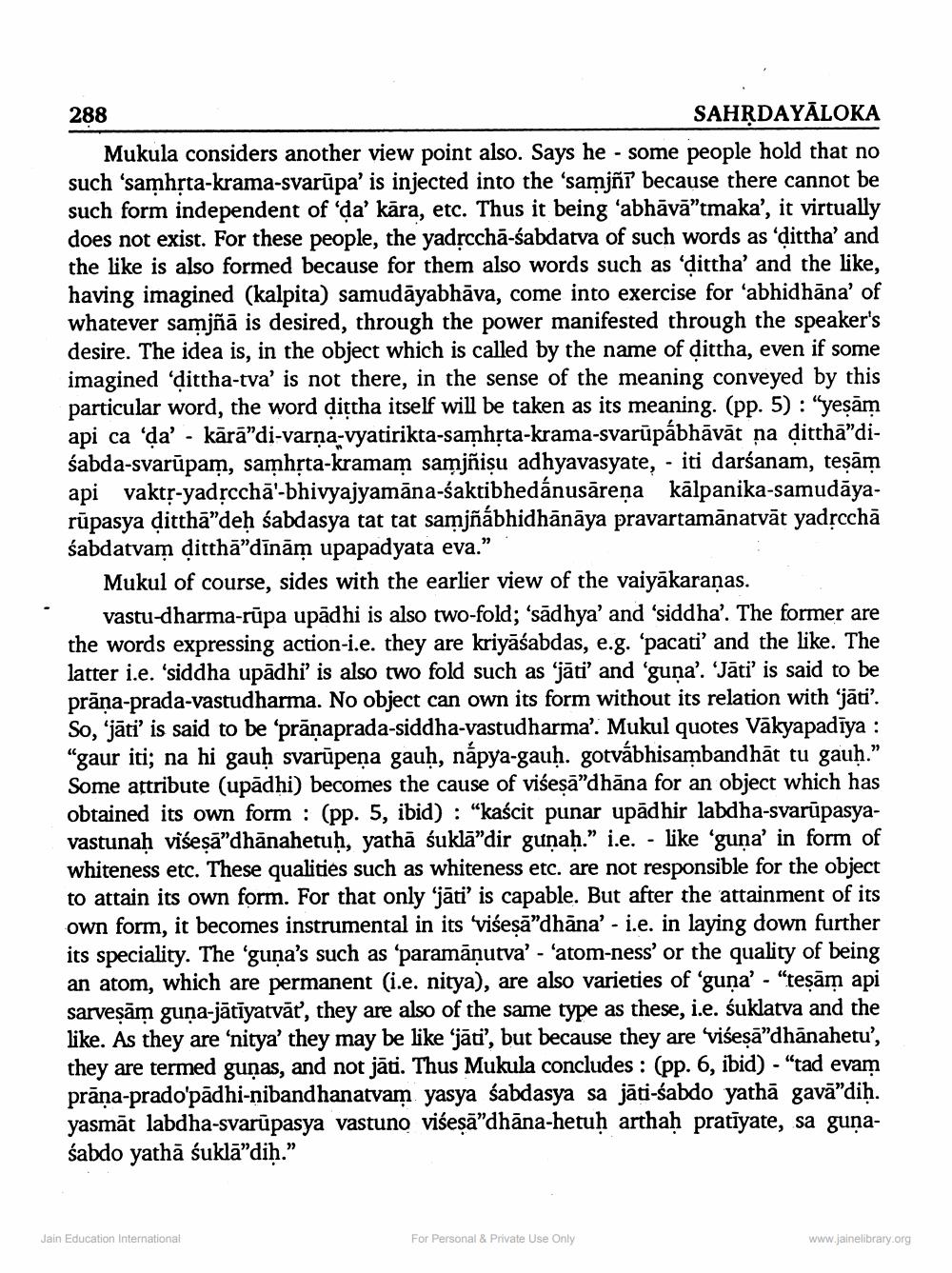________________
SAHṚDAYALOKA
Mukula considers another view point also. Says he - some people hold that no such 'samhṛta-krama-svarūpa' is injected into the 'samjñï' because there cannot be such form independent of 'da' kāra, etc. Thus it being 'abhāvā"tmaka', it virtually does not exist. For these people, the yadṛccha-sabdatva of such words as 'dittha' and the like is also formed because for them also words such as 'ḍittha' and the like, having imagined (kalpita) samudayabhāva, come into exercise for 'abhidhana' of whatever samjñā is desired, through the power manifested through the speaker's desire. The idea is, in the object which is called by the name of ḍittha, even if some imagined 'dittha-tva' is not there, in the sense of the meaning conveyed by this particular word, the word dittha itself will be taken as its meaning. (pp. 5): "yeṣām api ca 'ḍa' kārā"di-varṇa-vyatirikta-samhṛta-krama-svarupábhāvāt na dittha"diśabda-svarūpam, samhṛta-kramam samjñiṣu adhyavasyate, iti darśanam, teṣām api vaktṛ-yadṛccha'-bhivyajyamāna-saktibhedánusāreņa kālpanika-samudayarūpasya ḍittha"deḥ śabdasya tat tat samjñábhidhānāya pravartamānatvāt yadṛcchā śabdatvam ditthā"dīnām upapadyata eva."
288
-
Mukul of course, sides with the earlier view of the vaiyakaraṇas.
vastu-dharma-rupa upādhi is also two-fold; 'sadhya' and 'siddha'. The former are the words expressing action-i.e. they are kriyāśabdas, e.g. 'pacati' and the like. The latter i.e. 'siddha upadhi' is also two fold such as 'jati' and 'guna'. 'Jāti' is said to be prāṇa-prada-vastudharma. No object can own its form without its relation with 'jāti'. So, 'jāti' is said to be 'prāṇaprada-siddha-vastudharma'. Mukul quotes Vakyapadīya : "gaur iti; na hi gauḥ svarupena gauḥ, nápya-gauḥ. gotvábhisambandhāt tu gauḥ." Some attribute (upadhi) becomes the cause of viseṣā"dhāna for an object which has obtained its own form (pp. 5, ibid) : "kaścit punar upadhir labdha-svarūpasyavastunaḥ viseṣā"dhānahetuḥ, yathā śuklā"dir gunah." i.e. like 'guna' in form of whiteness etc. These qualities such as whiteness etc. are not responsible for the object to attain its own form. For that only 'jāti' is capable. But after the attainment of its own form, it becomes instrumental in its 'viseṣā"dhana' - i.e. in laying down further its speciality. The 'guna's such as 'paramāņutva' - 'atom-ness' or the quality of being an atom, which are permanent (i.e. nitya), are also varieties of 'guna' - "teṣām api sarveṣām guna-jātīyatvāť, they are also of the same type as these, i.e. śuklatva and the like. As they are 'nitya' they may be like 'jati', but because they are 'viseṣā"dhanahetu', they are termed guņas, and not jāti. Thus Mukula concludes: (pp. 6, ibid) - "tad evam prāṇa-prado'pādhi-nibandhanatvam yasya sabdasya sa jāti-śabdo yathā gavā"diḥ. yasmāt labdha-svarūpasya vastuno viseṣā"dhana-hetuḥ arthaḥ pratiyate, sa guṇaśabdo yathā śuklā"diḥ."
Jain Education International
For Personal & Private Use Only
-
www.jainelibrary.org




